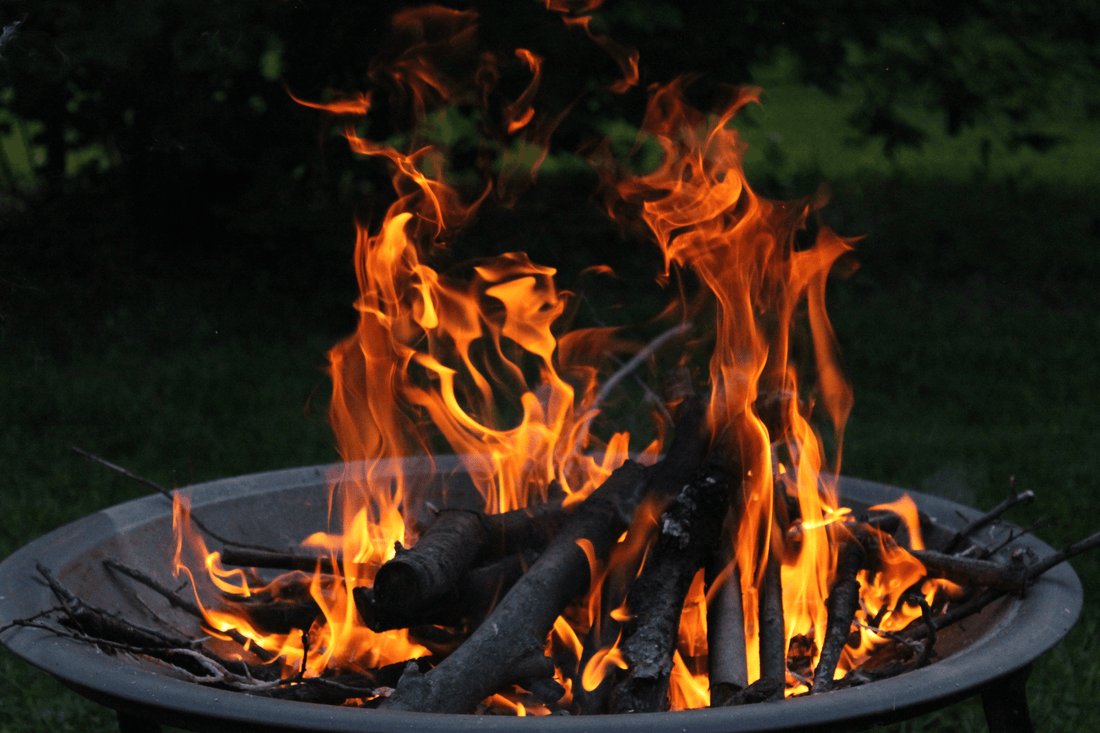Our mission is to provide your backyard with our products that will create unforgettable experiences for your family and friends and one way to ruin that is a fiery accident! So we recommend anyone purchasing our fire pits to read this article.
Embers and Sparks
This is one of the most common and sneaky ways fires can reach their incipient stage.
Wood, paper, oil, grease, gasoline and leaking natural gas like propane and acetylene are all fuels for a disaster if you're not mindful of your surroundings when your fire pit is actively burning. It is recommended to cover your fire pit with a spark screen when not roasting marshmallows or cooking. Keep fire pit at least 25ft away from flammable materials as wind can carry the hot sparks and embers toward them and ignite explosions or cause uncontrollable flames.
Wood can smolder for hours to a day and eventually progress to its growth stage if embers and sparks reach it. Use of fire pits on wooden decks is ill-advised.
Flames, Heat and Combustion
It's only common sense to never touch flames but accidents can still happen here's how to avoid them:
Keep the immediate area around the fire pit clear to avoid tripping on or into the burning fire pit or tipping over the fire pit itself. Keep all limbs outside the fire pit while flames are active. If you are using a propane or any gas powered fire pit, always check for leaks. When the gas cylinder is connected to the fire pit, turn open the gas cylinder slightly, spray the connecting valve with soapy water to see if any gas is leaking, if so DO NOT start the fire pit.
Wait at least 25 minutes to allow the fire pit to cool down before touching or moving the fire pit after use.
DO NOT USE LIGHTER FLUID, GASOLINE OR ANY LIQUID FUEL TO START THE FIRE PIT. Combustion can cause severe burns, injuries and even death.
How to Kill a Fire During an Emergency
The three components to the fire triangle are:
- Fuel
- Oxygen
- Heat

If you eliminate one of the three components from the fire triangle, you have extinguished the fire! Here are some tips on how to do so.
Smothering The Fire
Only when a fire is in its incipient stage or (initial flame), smothering the fire by laying a blanket, or tarp over the flame or simply enclosing the flame in a tight, confined space like placing the lid back on your yankee candle while it is lit will remove the oxygen from the triangle. Fire, similar to most living beings cannot breathe without oxygen and the fire will die without it. A fire blanket is the best tool for this job. It is not recommended to attempt smothering the fire when the flame is past its growth stage.
Extinguishing the Fire:
This is the most common method of putting out a fire and the old fashioned way! Fire extinguishers contain chemicals that are capable of smothering the flame, cooling the heat AND the fuel source (the burning wood) thus removing all 3 components of the fire triangle from the equation. Water by itself can put out or extinguish many types of fires, water can also separate the source of oxygen from the fire. There are various extinguisher classes and since we're dealing with burning wood, a Class A extinguisher would be the ideal choice. All the extinguisher classes are listed below.
- Class A- Wood, Paper, Cloth and other ordinary combustibles.
- Class B- Oils, Fuel, Paints and Solvents
- Class C- Live Electrical Equipment
- Class D- Combustible Metals
- Class K- Combustible Kitchen Equipment
Removing the Fire's Fuel
The fire's fuel source is the foundation to any fire and depriving it of fuel will instantly starve the fire out. Here's a perfect example of fuel removal
The welder in the image below is cutting steel with an Oxy-Acetylene cutting torch.

The torch produces flame with Oxygen and Acetylene which are running from the fuel cylinder, through the connecting hoses and fed to the torch.

Acetylene is the fuel that creates the flame in this example. When the cylinder is closed or the corresponding acetylene valve on the torch handle is closed, only oxygen will be expelled from the torch, therefore you don't have a flame.
Fires cannot exist without Fuel, Oxygen and Heat. If you can remove any of these three factors that's one less fire to worry about! I hope this guide helps so stay safe and enjoy our fire pits! Keep making those unforgettable memories in your backyard, garden or patio because in the end it is our goal to help you create them.

